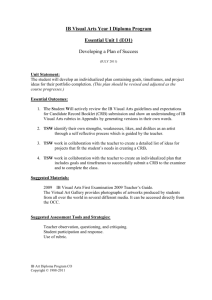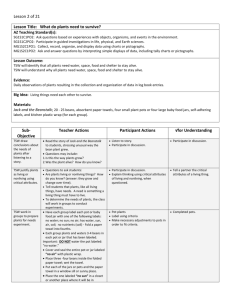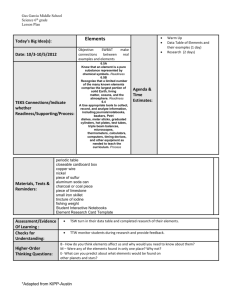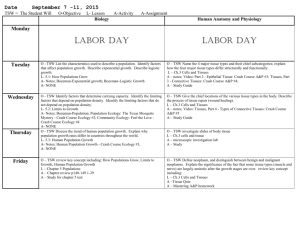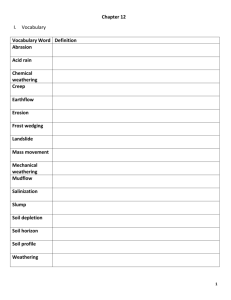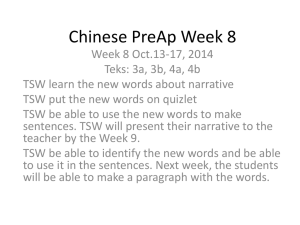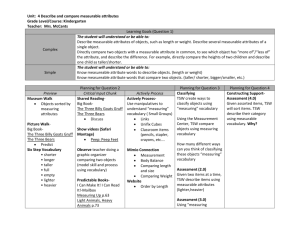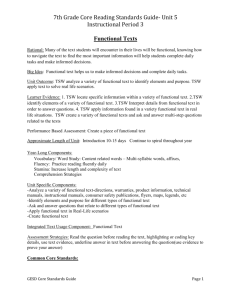12-13 EARTH SCI E05 11
advertisement
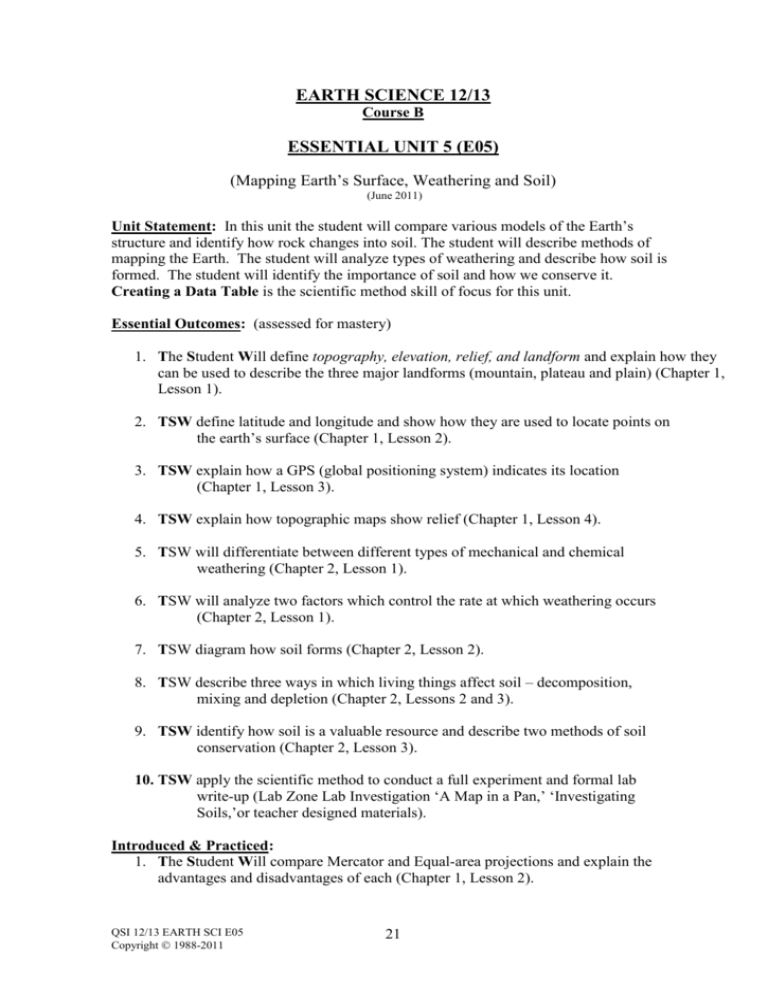
EARTH SCIENCE 12/13 Course B ESSENTIAL UNIT 5 (E05) (Mapping Earth’s Surface, Weathering and Soil) (June 2011) Unit Statement: In this unit the student will compare various models of the Earth’s structure and identify how rock changes into soil. The student will describe methods of mapping the Earth. The student will analyze types of weathering and describe how soil is formed. The student will identify the importance of soil and how we conserve it. Creating a Data Table is the scientific method skill of focus for this unit. Essential Outcomes: (assessed for mastery) 1. The Student Will define topography, elevation, relief, and landform and explain how they can be used to describe the three major landforms (mountain, plateau and plain) (Chapter 1, Lesson 1). 2. TSW define latitude and longitude and show how they are used to locate points on the earth’s surface (Chapter 1, Lesson 2). 3. TSW explain how a GPS (global positioning system) indicates its location (Chapter 1, Lesson 3). 4. TSW explain how topographic maps show relief (Chapter 1, Lesson 4). 5. TSW will differentiate between different types of mechanical and chemical weathering (Chapter 2, Lesson 1). 6. TSW will analyze two factors which control the rate at which weathering occurs (Chapter 2, Lesson 1). 7. TSW diagram how soil forms (Chapter 2, Lesson 2). 8. TSW describe three ways in which living things affect soil – decomposition, mixing and depletion (Chapter 2, Lessons 2 and 3). 9. TSW identify how soil is a valuable resource and describe two methods of soil conservation (Chapter 2, Lesson 3). 10. TSW apply the scientific method to conduct a full experiment and formal lab write-up (Lab Zone Lab Investigation ‘A Map in a Pan,’ ‘Investigating Soils,’or teacher designed materials). Introduced & Practiced: 1. The Student Will compare Mercator and Equal-area projections and explain the advantages and disadvantages of each (Chapter 1, Lesson 2). QSI 12/13 EARTH SCI E05 Copyright 1988-2011 21 2. TSW explain how satellites and computers have revolutionized mapmaking (Chapter 1, Lesson 3). 3. TSW explain how uniformitarianism allows geologists to infer how earth’s land formed (Chapter 2, Lesson 1). Key Terms: topography elevation relief landform plain mountain range plateau region globe symbol key scale degree equator hemisphere prime meridian latitude longitude surveying pixel contour line uniformitarianis m erosion weathering chemical weathering mechanical weathering abrasion frost wedging oxidation permeable soil bedrock humus fertility loam pH scale topsoil subsoil natural resource conservation SUGGESTED RESOURCES & RUBRICS FOUND ON FOLLOWING PAGES……………. QSI 12/13 EARTH SCI E05 Copyright 1988-2011 22 Suggested Materials: Interactive Science, Earth’s Surface by Pearson, Chapters 1 and 2 Suggested Unit Resources: 1. Lab Zone; fully editable CD-Rom; Chapter Lab Investigations, Inquiry Warm-Ups, and Quick Labs (refer to Interactive Science – Earth’s Surface, page vi, and vii for a specific list of labs available for this unit). 2. Lab Zone Inquiry skills for each lesson as suggested in Interactive Science – Earth’s Structure, Contents, page vi and vii). 3. Study Guide & Review and Assessment for Interactive Science – Earth’s Surface Chapters 1 and 2. 4. ‘A Map in a Pan’ and ‘Investigating Soils’ complete lab investigations on Lab Zone CD-Rom or Teacher’s Lab Resource – Earth’s Surface. 5. Untamed Science Video Series 6. Other ancillary materials, if available. Technology Resources: 1. http://www.myscienceonline.com activities; The Big Question, Vocab Flash Cards, Interactive Art, Planet Diary, Virtual Lab, Untamed Science, My Science Coach, and My Reading Web. Use keywords ‘Mapping Earth’s Surface,’ and ‘Changing Earth’s Surface.’ 2. The Library’s online database – Destiny Webpath Express 3. http://www.unitedstreaming.com if your school has a membership. 4. Google Earth – http://www.earth.google.com Suggested Assessment Tools and Strategies: 1. Any of the Inquiry skill activities you utilize from the text (TSWs 1-11) 2. Students construct a relief model showing land forms (TSW’s 1, 2, and 4). 3. Students keep a journal of observations, ideas, and findings reflecting on reading, experiments, and class discussions (TSW’s 1 - 9). 4. Students create a globe and use it to model how a GPS can find location (TSW 3). 5. Students will conduct a lab to simulate chemical and mechanical weathering (TSW 5). 6. Students write a report, create a poster, and/or give a class presentation on any of the relevant topics (TSW’s 1 - 9). 7. Teacher generated and/or published tests and assessments (TSW’s 1 - 9). 8. For the formal lab, ‘A Map in a Pan’ and ‘Investigating Soils and Drainage’ Lab Zone investigations and write-ups are good full labs designed by Pearson. The open inquiry is higher level and requires more from the student (TSW 10), RUBRICS FOUND ON FOLLOWING PAGE………………………… QSI 12/13 EARTH SCI E05 Copyright 1988-2011 23 Suggested Rubric for E05 TSW ‘A’ Level Mastery ‘B’ Level Mastery 1 – Terms and The student is able to model or The student is able to define landforms diagram the difference between topography, relief, elevation, and relief and elevation. ladform. The student is able to describe the topography, relief and elevation of plains, plateaus and mountains. 2 – Latitude The student can define latitude and and longitude longitude and locate cities on a map by their coordinates. 3 – How a The student is able to explain the The student is able to explain that a GPS finds process of how several satellites are GPS finds location by reading the location needed to find exact location distance from satellites. through the use of a model or diagram (triangulation). 4– The student is able to measure The student is able to match a Topographic change in elevation using a detailed topographic map to each type of maps topographic map. landform. 5 – Types of The student is able describe the two Weathering types of weathering and cite at least 2 differences. 6 – Rate of The student can analyze how The student can name two factors that weathering different types of climate and rock influents the rate of weathering. can affect chemical and mechanical weathering respectively.. 7 – Soil The student is able to differentiate The student diagrams soil formation. formation between soil horizons and soil composition using the correct terminology. 8 – Living The student is able to describe how things living things can cause decomposition, affecting soil mixing, and depletion. 9 – Types of The student is able to analyze what The student is able to state why soil is volcanoes types of soil would be best for a valuable resource to humans and farming and connect soil explain two ways we conserve soil. conservation with fighting erosion and depletion. 10 – Scientific See Tier III of the QSI Formal Lab See Tier III of the QSI Formal Lab Method Assessment (following page). In Assessment (following page). Adjust addition the student should be able as necessary. to complete the ‘Open Inquiry’ lab if using the Lab Investigation from Lab Zone. Adjust as necessary. To receive an ‘A’, the student must show ‘A’ level mastery in at least 4 of the 6 available TSW’s and ‘B’ level mastery on all of the remaining TSW’s. To receive a ‘B’, the student must show ‘B’ level mastery on all nine TSW’s. QSI 12/13 EARTH SCI E05 Copyright 1988-2011 24 Tier III Lab Report Rubric Evaluation Rubric Name __________________________ Lab # ______ Date _______________ Design Title: Clearly describes the purpose of the lab. P B A Background/Information: Student summarizes relevant background information in paragraph form. P B A Research Question: Identifies question addressed by the lab. P B A Hypothesis: Creates a prediction using an “if…then…” statement. P B A Materials: All the materials used are listed in bullet form. P B A P B A Data Collection Results given are in two sections: Raw data tables appropriately labeled. P B A Conclusion & Evaluation Conclusion: States the relationship between the variables based on the data. P B A P B A P B A P B A P B A Procedures: All steps listed in a clear format such that the lab could be repeated by anyone. Evaluation: Student explains what was learned from the experiment. and recommends future improvements for the procedures. Manipulative Skills Follows instructions: Follows instructions accurately; adapts to new circumstances; seeks assistance only when required. Carries out techniques: Competent and methodical in the use of a range of techniques and equipment. Works safely & ethically: Pays attention to safety issues; does not expose self or others to safety risks, experiments have little or no negative effect on environment; inflicts no pain or harm living animals, & shows due consideration to human subjects, including informed consent. Comments:_________________________________________________________________ ___________________________________________________________________________ Total Evaluation: QSI 12/13 EARTH SCI E05 Copyright 1988-2011 Points: _________ Percentage: _________ 25

